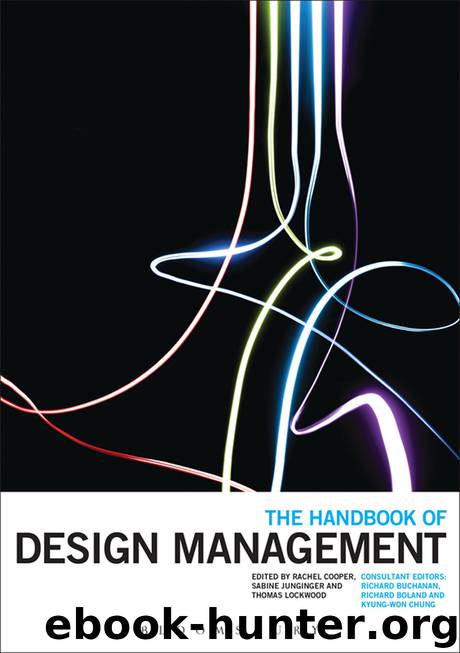The Handbook of Design Management by Lockwood Thomas. Junginger Sabine. Cooper Rachel

Author:Lockwood, Thomas.,Junginger, Sabine.,Cooper, Rachel
Language: eng
Format: epub
Publisher: Bloomsbury UK
Published: 2013-09-21T16:00:00+00:00
FUNDAMENTALS
In my previous research based on management models (Borja de Mozota 1992) a convergent model of design management was developed based on two perspectives: the reactive or managerial approach and the proactive design approach.
The managerial approach involves enhancing design impact in organizations by accommodating management concepts. All management paradigms are examined in order to choose the ideas and methods that will make design more efficient. This can be achieved by linking design with concepts such as organization, reputation or strategy. This perspective applies the different theories of management – scientific, behavioural, decisional, systemic, situational – to design issues. The role of design management is to improve design with managerial knowledge.
In contrast, the design approach involves examining design as a new paradigm in order to arrive at ideas and methods that can be used to enhance the efficiency of management in general and design management in particular. Since a different vision of organizational reality emerges from the science of design, the management system is enriched by design. The objective of design management is, then, to improve management with design knowledge (Junginger 2006).
In this chapter, the longitudinal study of the theory of strategic value design in organizations refers to the managerial approach of design management and to the concept of strategy and competitive advantage.
The first research question is simple: ‘what is the value of design for strategy in organizations?’ So the theoretical background is both strategy theory and design theory. The main finding is that design is a function of organizations and, consequently, a management method. Therefore evidence is given for the second approach of design management based on a new theory of strategic management: the resource based view of strategy.
Having explained our research approach, why focus on value? Value is what motivates human activities. Value, according to Peter Drucker (1967) is the essence of what organizations are. Managing for value is not just about profit making; it is also about bringing about long-term changes such as shareholders’ value. Our analysis is not about implementing simplistic economic metrics such as Stern Stewart’s Economic Value Added (EVATM, New York) as a key measure of performance. Value is not only about change in the accounting system; it is about commitment to shareholders and to stakeholders’ value. It is about facing resistance to change in order to implement the desired cultural transformation that will enable all the workers, including designers, to make value creating decisions.
The main contributions of value-based management (Haspeslagh et al. 2001) are: to understand where value is created or destroyed in companies, to make employees appreciate that capital has a cost, to make managers focus on the balance sheet, to allocate resources towards the most productive uses, to make sure that business units make a profit that cover the cost of capital, to make managers act like owners of the company, to improve communication between business units and the corporate centre, to improve stock prices and to make strategic planning less of a paper exercise.
Value is also the aim of the design activity.
Download
This site does not store any files on its server. We only index and link to content provided by other sites. Please contact the content providers to delete copyright contents if any and email us, we'll remove relevant links or contents immediately.
| Decorative Arts | Design History & Criticism |
| Furniture Design | Industrial & Product Design |
| Interior & Home Design | Jewelry Design |
| Textile & Costume |
POP by Steven Heller(3307)
Japanese Design by Patricia J. Graham(3109)
The Power of Broke by Daymond John(2897)
Architecture 101 by Nicole Bridge(2764)
Indistractable: How to Control Your Attention and Choose Your Life by Nir Eyal(2334)
Fusion 360 for Makers by Lydia Sloan Cline(2308)
Batik by Rudolf Smend(2123)
Actionable Gamification: Beyond Points, Badges, and Leaderboards by Yu-kai Chou(2122)
Origami Art by Michael G. Lafosse & Richard L. Alexander(2065)
Homebody by Joanna Gaines(2031)
Whiskey in a Teacup by Reese Witherspoon(1936)
Worn in New York by Emily Spivack(1926)
Feng Shui by Stephen Skinner(1900)
Austin Kleon by Steal Like an Artist(1887)
Simple Gatherings by Melissa Michaels(1855)
Don't Make Me Think, Revisited: A Common Sense Approach to Web Usability by Steve Krug(1826)
Hygge: The Danish Art of Happiness by Marie Tourell Søderberg(1693)
The Joy of Hygge by Jonny Jackson(1685)
The Laws of Simplicity by John Maeda(1568)
